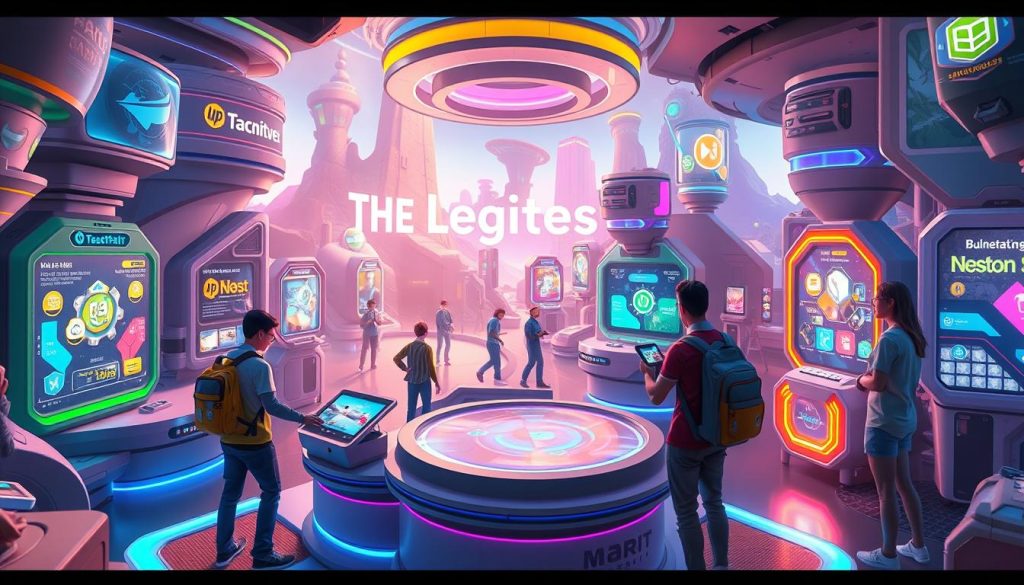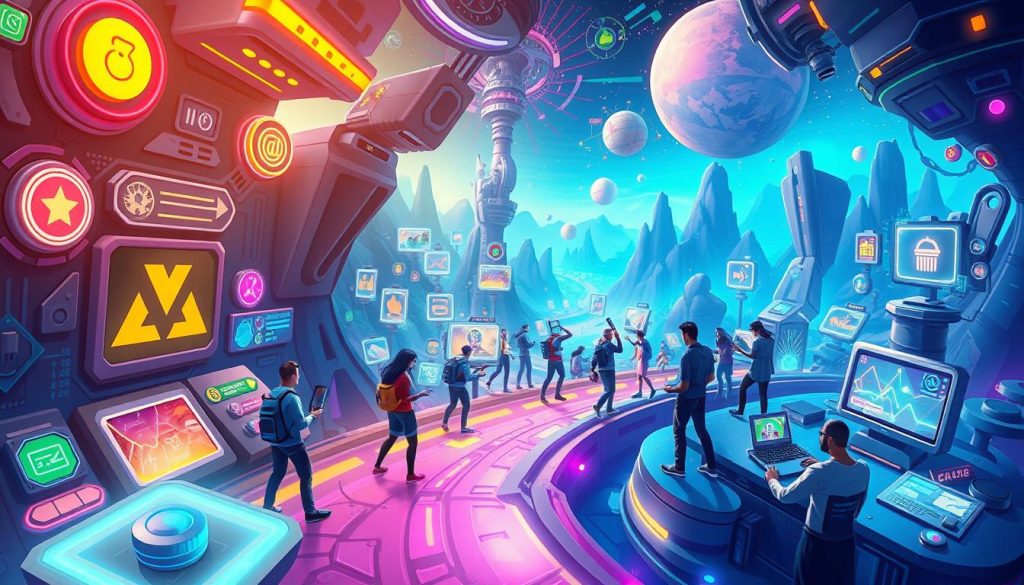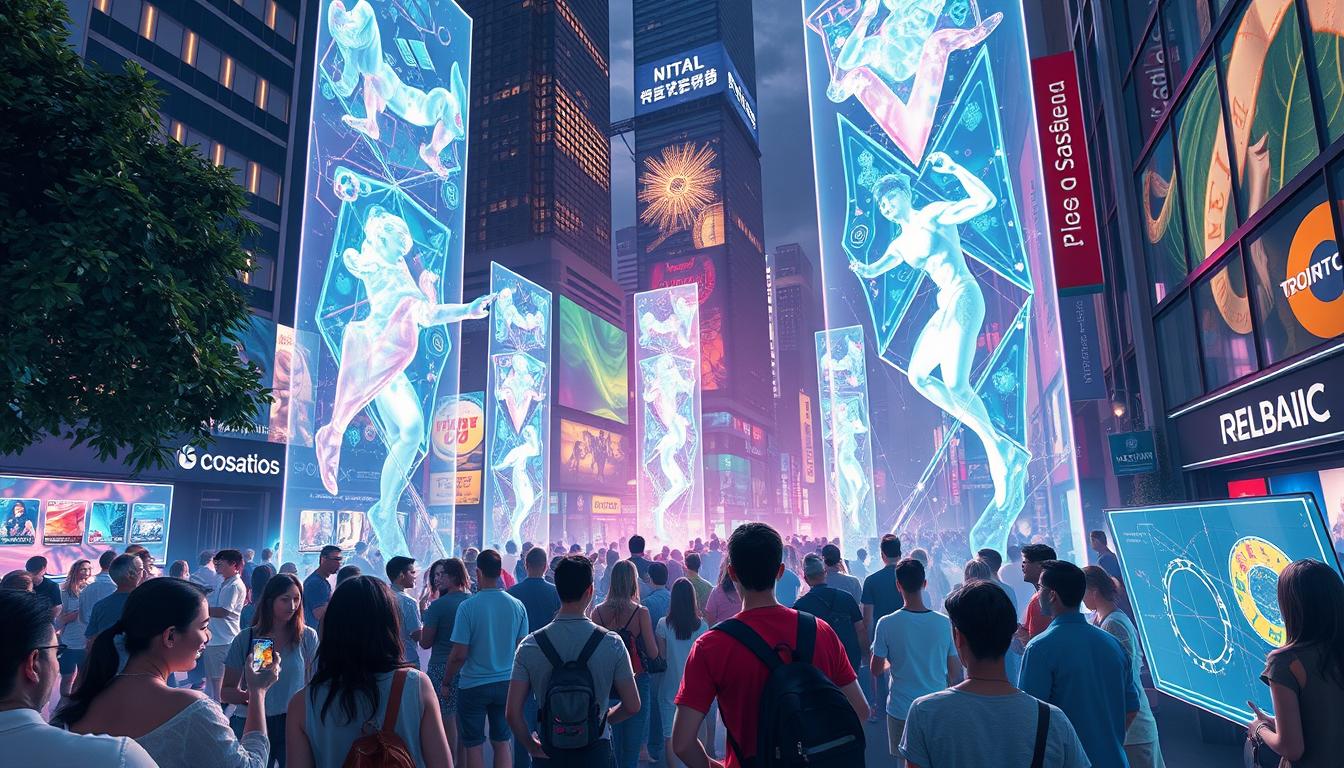In today’s fast-paced world of marketing, standing out from the crowd is key. Tradeshows offer a unique chance to make a lasting impression on potential customers. But how can you ensure your brand sticks in their minds? Enter the world of branded games and interactive experiences.
Brand activation through gaming is revolutionizing the way companies connect with their audience. These engaging activities create memorable moments that go beyond traditional marketing tactics. By tapping into the power of play, businesses can forge stronger connections and boost brand recall like never before.
Experiential marketing takes center stage as companies realize the impact of immersive encounters. Interactive experiences at tradeshows not only draw crowds but also leave a lasting imprint on attendees’ memories. This innovative approach transforms passive observers into active participants, dramatically increasing the chances of your brand being remembered long after the event ends.
Key Takeaways
- Branded games enhance brand recall at tradeshows
- Interactive experiences create memorable moments for attendees
- Experiential marketing boosts audience engagement
- Gaming elements transform passive observers into active participants
- Immersive brand encounters lead to stronger customer connections
- Innovative marketing tactics increase long-term brand recognition
Understanding Brand Recall and Its Importance in Modern Marketing
Brand recall plays a crucial role in today’s competitive market. It’s the ability of customers to remember your brand when thinking about a specific product or service. In the beauty industry, strong brand recall can lead to increased customer retention and loyalty.
The Psychology Behind Brand Memory
Our brains process countless brand impressions daily. Effective brand recall taps into how memory works. Repetition, emotional connection, and unique experiences all contribute to forming lasting brand memories. This is why customer journey mapping is so important – it helps create memorable touchpoints throughout the customer experience.
Why Brand Recall Matters in Today’s Market
In a sea of choices, brand recall can make or break a business. When customers easily remember your brand, they’re more likely to choose it over competitors. This leads to:
- Increased sales and revenue
- Higher customer loyalty
- Positive word-of-mouth marketing
- Stronger market position
Measuring Brand Recall Effectiveness
To gauge brand recall success, businesses use various methods:
| Method | Description | Advantage |
|---|---|---|
| Surveys | Ask customers to name brands in a category | Direct feedback |
| Purchase behavior | Track repeat purchases | Shows real-world impact |
| Social media mentions | Monitor brand mentions online | Measures organic reach |
By focusing on brand recall and providing exceptional customer service, beauty businesses can create lasting impressions that drive long-term success.
How Branded Games Boost Brand Recall at Tradeshows
Tradeshows buzz with energy, but standing out can be tough. That’s where gamification shines. Branded games at tradeshows create a fun, interactive way to boost brand recall and engage visitors.
Games grab attention and keep folks at your booth longer. This extra time means more chances to share your message. A well-designed game can teach about your products while entertaining. It’s a win-win for trade show engagement.
Interactive experiences stick in memory better than passive ones. When people play, they connect emotions with your brand. This combo of fun and learning makes a lasting impression.
“Play is our brain’s favorite way of learning.” – Diane Ackerman
Here’s why branded games work so well:
- They break the ice, making it easier to start conversations
- Competition adds excitement and draws crowds
- Prizes give visitors a reason to remember you
- Social elements encourage sharing, extending your reach
By using games, you’re not just another booth with brochures. You’re creating an experience that people will talk about long after the show ends. This strategy turns visitors into brand ambassadors, spreading word-of-mouth buzz.
Remember, the key is to balance fun with your brand message. A game that’s too complex might overshadow your products. Keep it simple, relevant, and tied to your core offerings for the best results in boosting brand recall.
The Science of Gamification in Brand Marketing
Gamification in brand marketing taps into human psychology to create lasting impressions. By merging immersive branding with interactive elements, companies can boost engagement and recall. Let’s explore how this approach works on a cognitive level.
Cognitive Benefits of Interactive Experiences
Interactive experiences stimulate multiple senses, enhancing information processing. When customers engage with branded games, their brains form stronger neural connections. This active participation leads to better retention of brand messages compared to passive advertising.
Emotional Connection Through Play
Games trigger positive emotions like joy and excitement. These feelings create a strong bond between the player and the brand. Experiential marketing through games fosters a sense of achievement, further strengthening this emotional tie. Utilizing platforms like GoHighLevel can help businesses track these emotional responses and tailor their strategies accordingly.
Memory Formation and Gaming Mechanics
Gaming mechanics play a crucial role in memory formation. Repetition, rewards, and challenges all contribute to lasting brand recall. Here’s how different game elements impact memory:
| Game Element | Impact on Memory | Brand Benefit |
|---|---|---|
| Points System | Reinforces positive behaviors | Increased engagement with brand |
| Leaderboards | Sparks competitive spirit | Prolonged interaction time |
| Storylines | Creates emotional investment | Deeper brand connection |
By leveraging these elements, brands can create memorable experiences that stick with consumers long after the game ends. This approach to immersive branding not only entertains but also educates and persuades, making it a powerful tool in modern marketing strategies.
Creating Immersive Brand Experiences Through Interactive Games
Interactive experiences are revolutionizing brand activation strategies at tradeshows. By harnessing the power of games, companies can create lasting impressions that boost brand recall long after the event ends.

Immersive gaming experiences captivate attendees, drawing them into your brand’s world. These engaging activities go beyond traditional marketing, offering a unique blend of entertainment and information that resonates with modern consumers.
To craft effective interactive games, consider these key elements:
- Align game mechanics with brand values
- Incorporate product features into gameplay
- Design visually appealing interfaces that reflect brand aesthetics
- Create challenges that educate players about your offerings
By integrating these components, you’ll create a memorable experience that reinforces your brand message. Attendees who participate in these games are more likely to remember your company and engage with follow-up marketing efforts, such as email campaigns.
“Interactive games at tradeshows can increase brand recall by up to 70% compared to traditional booth displays.”
To maximize the impact of your interactive experiences, consider incorporating virtual or augmented reality elements. These cutting-edge technologies can transport attendees into immersive brand environments, creating unforgettable moments that stick in their minds long after the tradeshow ends.
Remember, the goal is to create an experience that’s both fun and informative. By striking this balance, you’ll ensure that your brand activation efforts leave a lasting impression on potential customers, driving long-term engagement and loyalty.
Designing Effective Brand Activation Strategies
Creating impactful brand activation strategies through gamification requires a thoughtful approach. By understanding your audience and leveraging the right game mechanics, you can craft experiences that resonate and leave a lasting impression.
Identifying Target Audience Preferences
Successful brand activations start with knowing your audience. Use customer journey mapping to gain insights into their behaviors and preferences. This process helps tailor your gamification efforts to match their interests and engagement styles.
Selecting Appropriate Game Mechanics
Choose game mechanics that align with your brand and audience. Popular options include:
- Point systems
- Leaderboards
- Challenges and quests
- Virtual rewards
These elements can drive engagement and motivation, making your brand experience more memorable and enjoyable.
Incorporating Brand Elements Seamlessly
Integrate your brand identity into the game experience without being overly promotional. Use your brand colors, logos, and messaging subtly throughout the game. This approach ensures brand recall while maintaining an enjoyable user experience.
“Gamification isn’t just about fun; it’s about creating meaningful connections between brands and consumers through interactive experiences.”
By focusing on these key areas, you can design brand activation strategies that captivate your audience and boost brand recall. Remember, the goal is to create an experience that feels natural and engaging, not forced or overly promotional.
Maximizing Lead Generation Through Gaming Elements
Trade show engagement reaches new heights when gaming elements enter the mix. By incorporating interactive experiences, businesses can supercharge their lead generation efforts. Gaming at trade shows captivates attendees, making them more likely to share contact information and engage with your brand.

Gamification transforms passive booth visitors into active participants. Quizzes, digital scavenger hunts, and virtual reality experiences not only entertain but also collect valuable data. This approach allows for seamless lead capture and nurturing, turning casual interactions into qualified prospects.
To maximize lead generation, consider these gaming strategies:
- Leaderboards to spark competition
- Reward systems for information sharing
- Progressive challenges to keep engagement high
- Personalized game paths based on attendee interests
By integrating these elements, you create a win-win scenario. Attendees enjoy an immersive experience while you gather crucial lead information. This data can then fuel targeted follow-ups and personalized marketing campaigns long after the trade show ends.
| Gaming Element | Lead Generation Benefit | Engagement Metric |
|---|---|---|
| Interactive Quiz | Captures industry-specific knowledge | Completion rate |
| Virtual Scavenger Hunt | Encourages booth exploration | Time spent at booth |
| VR Product Demo | Showcases product features | Demo-to-inquiry ratio |
| Digital Spin-to-Win | Collects contact information | Email opt-in rate |
Remember, the key to successful lead generation through gaming lies in striking the right balance between fun and relevance. Your games should reflect your brand values and resonate with your target audience, ensuring that every interaction contributes to meaningful business relationships.
Technology Integration for Enhanced Brand Recall
Cutting-edge tech is revolutionizing brand experiences at tradeshows. By integrating advanced technologies, companies create interactive experiences that stick in visitors’ minds. These immersive branding tactics go beyond traditional marketing, leveraging social media integration to amplify reach and engagement.
Augmented reality (AR) transforms ordinary booth spaces into captivating virtual worlds. Visitors can interact with 3D product models, explore virtual showrooms, or play branded AR games. This blend of real and digital elements creates a memorable, multi-sensory experience.
Virtual reality (VR) takes immersion to the next level. Brands can transport attendees to virtual environments that showcase their products or services in action. These interactive experiences leave a lasting impression, boosting brand recall long after the event ends.
Mobile apps enhance engagement by gamifying the tradeshow experience. Attendees can participate in scavenger hunts, unlock rewards, or compete in branded challenges. These apps optimize user experience and keep the brand top-of-mind throughout the event.
| Technology | Engagement Level | Brand Recall Impact |
|---|---|---|
| Augmented Reality | High | Strong |
| Virtual Reality | Very High | Very Strong |
| Mobile Apps | Medium | Moderate |
By harnessing these technologies, brands create unforgettable immersive branding experiences that resonate with tradeshow attendees and significantly boost brand recall.
Measuring ROI of Gaming-Based Brand Activations
Evaluating the success of gaming-based brand activations is crucial for businesses looking to boost brand recall at tradeshows. By using advanced analytics tools, companies can gain valuable insights into their brand impressions and lead generation efforts.
Key Performance Indicators
To gauge the effectiveness of branded games, focus on metrics like engagement rates, time spent interacting with the game, and the number of leads captured. These KPIs help quantify the impact of your activation on brand recall and potential customer acquisition.
Data Collection Methods
Gathering accurate data is essential for measuring ROI. Implement in-game tracking, post-event surveys, and follow-up emails to collect valuable information. These methods provide a comprehensive view of how your branded game influenced attendees’ perceptions and actions.
Success Metrics Analysis
Analyze the collected data to determine the overall success of your gaming-based activation. Compare lead quality and quantity against previous marketing efforts to assess improvement in brand recall and lead generation. This analysis helps refine future strategies and justify investment in interactive brand experiences.
FAQ
What are branded games and how do they boost brand recall at tradeshows?
Branded games are interactive experiences designed to engage tradeshow attendees while promoting a company’s brand. They boost brand recall by creating memorable, fun interactions that help attendees associate positive emotions with your brand, making it more likely they’ll remember you long after the event.
How effective are branded games compared to traditional marketing methods at tradeshows?
Branded games are often more effective than traditional marketing methods at tradeshows because they provide an immersive experience. They can increase engagement, dwell time at your booth, and create stronger emotional connections, leading to better brand recall and potentially higher conversion rates.
What types of branded games work best for boosting brand recall?
The most effective branded games for boosting brand recall are those that align with your brand values and target audience preferences. This could include interactive quizzes, augmented reality experiences, virtual reality simulations, or physical games that incorporate your products or services. The key is to make the game engaging, relevant, and memorable.
How can we measure the success of our branded game in terms of brand recall?
You can measure the success of your branded game through various methods, including post-event surveys, social media mentions, booth traffic analysis, lead quality assessment, and follow-up interactions. Key performance indicators might include the number of game participants, time spent at your booth, and the ability of attendees to recall your brand in follow-up communications.
Are there any potential drawbacks to using branded games at tradeshows?
While branded games can be highly effective, potential drawbacks include high development costs, technical difficulties, or games that overshadow your actual product or message. It’s crucial to strike a balance between entertainment and brand messaging to ensure the game enhances rather than detracts from your overall tradeshow objectives.
How can we integrate lead generation into our branded game experience?
You can integrate lead generation into your branded game by requiring participants to provide contact information before playing, offering in-game incentives for data sharing, or creating a leaderboard that captures player details. Just ensure that the data collection process doesn’t disrupt the flow of the game or diminish the user experience.
What role does technology play in creating effective branded games for tradeshows?
Technology plays a crucial role in creating engaging branded games. Augmented reality, virtual reality, touchscreen interfaces, and mobile applications can all enhance the immersive experience. These technologies can create more sophisticated, interactive, and memorable games that stand out on the tradeshow floor.
How do branded games contribute to customer journey mapping?
Branded games contribute to customer journey mapping by providing valuable insights into attendee behavior, preferences, and engagement levels. By analyzing game participation and performance, you can better understand your audience’s interests and tailor your marketing strategies accordingly, enhancing the overall customer journey.


